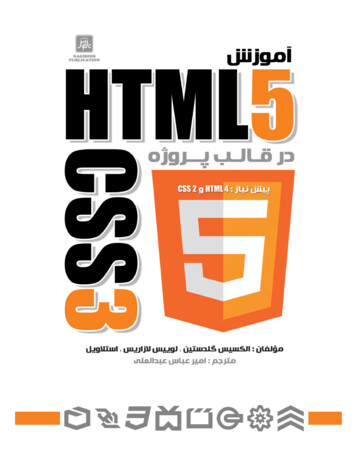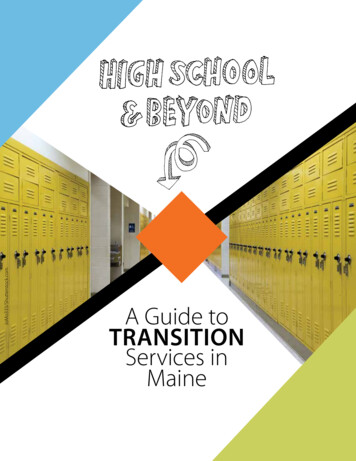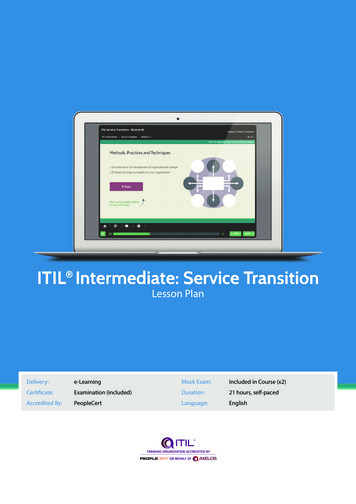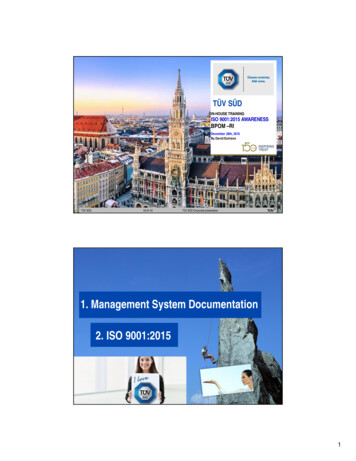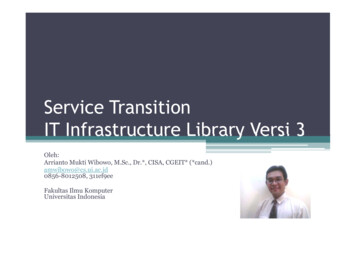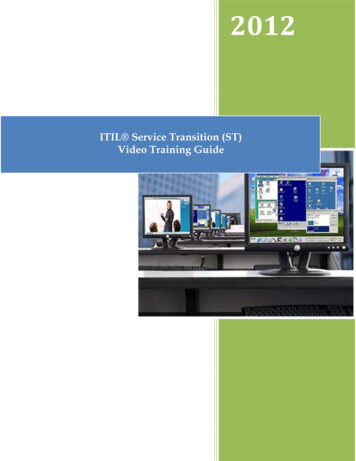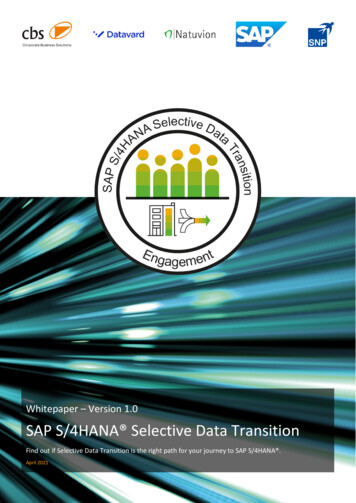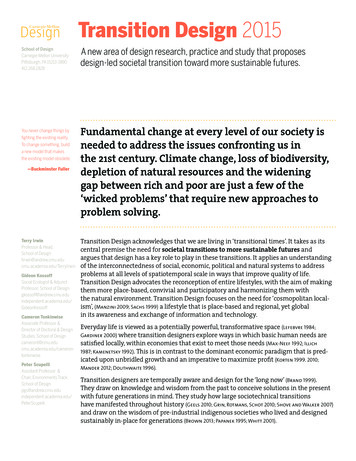
Transcription
Carnegie MellonSchool of DesignCarnegie Mellon UniversityPittsburgh, PA 15213-3890412.268.2828You never change things byfighting the existing reality.To change something, builda new model that makesthe existing model obsolete.—Buckminster FullerTerry IrwinProfessor & Head,School of rwinGideon KossoffSocial Ecologist & AdjunctProfessor, School of edu/GideonKossoffCameron TonkinwiseAssociate Professor &Director of Doctoral & DesignStudies, School of inwisePeter ScupelliAssistant Professor &Chair, Environments TrackSchool of eterScupelliTransition Design 2015A new area of design research, practice and study that proposesdesign-led societal transition toward more sustainable futures.Fundamental change at every level of our society isneeded to address the issues confronting us inthe 21st century. Climate change, loss of biodiversity,depletion of natural resources and the wideninggap between rich and poor are just a few of the‘wicked problems’ that require new approaches toproblem solving.Transition Design acknowledges that we are living in ‘transitional times’. It takes as itscentral premise the need for societal transitions to more sustainable futures andargues that design has a key role to play in these transitions. It applies an understandingof the interconnectedness of social, economic, political and natural systems to addressproblems at all levels of spatiotemporal scale in ways that improve quality of life.Transition Design advocates the reconception of entire lifestyles, with the aim of makingthem more place-based, convivial and participatory and harmonizing them withthe natural environment. Transition Design focuses on the need for ‘cosmopolitan localism’, (Manzini 2009; Sachs 1999) a lifestyle that is place-based and regional, yet globalin its awareness and exchange of information and technology.Everyday life is viewed as a potentially powerful, transformative space (Lefebvre 1984;Gardiner 2000) where transition designers explore ways in which basic human needs aresatisfied locally, within economies that exist to meet those needs (Max-Neef 1992; Illich1987; Kamenetsky 1992). This is in contrast to the dominant economic paradigm that is predicated upon unbridled growth and an imperative to maximize profit (Korten 1999. 2010;Mander 2012; Douthwaite 1996).Transition designers are temporally aware and design for the ‘long now’ (Brand 1999).They draw on knowledge and wisdom from the past to conceive solutions in the presentwith future generations in mind. They study how large sociotechnical transitionshave manifested throughout history (Geels 2010; Grin, Rotmans, Schot 2010; Shove and Walker 2007)and draw on the wisdom of pre-industrial indigenous societies who lived and designedsustainably in-place for generations (Brown 2013; Papanek 1995; Whitt 2001).
The transition to sustainable futures calls for new ways of designing that are basedupon a deep understanding of how to design for change and transition within complexsystems (Irwin 2011). This knowledge and the new skillsets it will inform must be integratedfrom areas such as science, philosophy, psychology, social science, anthropology andthe humanities and will therefore challenge existing design paradigms. Transition Designis conceived as a new area for design education, practice and research and is presentedhere as a proposal and invitation for further discussion and debate among educators,practitioners and researchers. Origins of the Transition conceptShared by most transitiondiscourses is the contentionthat we need to step outof existing instiutional andepistemic boundaries if wetruly want to envision theworlds and practices capableof bringing about the significant transformations seenas needed. The projectseeks to develop a particularapproach to such a contention, based on a set ofconcepts derived from bothtrends in the academy andin social-political life.—Artuor EscobarTransicionesThe concept of transition is central to a variety of contemporary discourses and initiativesconcerned with how change manifests and can be catalyzed and directed in complexsystems. These discourses are found within academia, non-profit and community sectorsbut are often unrelated to each other or to the field of design. The concept of TransitionDesign acknowledges and draws from all of these approaches. It aspires to act as anintegrative agent among them and educate a generation of designers qualified to work intransdisciplinary teams developing transition solutions. These approaches include:Sociotechnical Transition Management Theory & Sustainability TransitionsOriginating in Northern Europe within the academic fields of Innovation Managementand Technology Assessment, these theories focus on how societal transitons happen.These approaches have been used as practical tools by the Dutch Government to managethe radical transformation of the energy systems in the early 2000s. These theoriesrepresent the convergence of sustainable development research, technology forecasting,social ecological impact analysis and the fields of social history and constructionof technology. They study the coevolution of technologies and their uses in order toconceive how innovations can be introduced into society to enable new ways of livingand working. (Elzen et al 2005; Geels 2010; Grin et al 2010)Transition Town NetworkTransition Towns was a community-based movement founded in Totnes, UK by RobHopkins in 2005. It has since grown into an international network of communities working to develop local resilience and autonomy and expand their capacity to respond and‘bounce back’ from external perturbations such as economic downturns, climate changeor disruptions to energy systems. Transition Towns develop local food and energy systems, alternative currencies and support the development of local businesses. (Hopkins2008)The Great Transition InitiativeThe Great Transition was a term first used in 1964 by the economist and systems theoristKenneth Boulding. In 1995 the Global Scenario Group began to produce a series ofreports identifying multiple future-based planetary scenarios and strategies for changethat could lead to the ‘Great Transition’ (improved quality of life, reduced poverty andinequity, human solidarity, enriched cultures and protection of the biosphere). In 2003the Tellus Institute lauched the Great Transition Initiative (GTI), an international networkof more than 40 scholars and activists who seek to develop and mobilize a planet-widecitizens transition movement. The concept of the Great Transition has also been adoptedby several leading think tanks such as the New Economics Foundation. (Raskin et al 2002)Transitions in complex systems‘Phase transition’ is a phenomenon that describes change within complex social andnatural systems that are dynamic, non-linear, self-organizing and interdependent.2
The term refers to the unexpected sudden ‘emergent’ changes that can occur in systemswhen they are subjected to outside stresses or ‘perturbations’. These changes areself-directed and cannot be predicted or controlled, yet are the source of new order (forms)and types of behavior (Goodwin 1998; Peat & Briggs 1999; Capra 1997). Important concepts and streams of thought for Transition DesignTransition Design draws upon multiple theories, streams of thought and movementsfrom varied fields and disciplines:We have fragmentedthe world into bits and piecescalled disciplines andsubdisciplines, hermeticallysealed from other suchdisciplines. As a result, after12 or 16 or 20 years ofeducation, most studentsgraduate without any broad,integrated sense of theunity of things. The consequences for their personhoodand for the planet are large.—David OrrEarth in MindLiving Systems TheoryWithin the last few decades, scientists within the ecological and biological fields haveproposed general principles for how all living systems work (Capra & Luisi 2014; Briggs & Peat1999; Prigogine & Stengers 1994; Wheatley 2006). Instead of examining phenomena by attempting to break things down into components, living systems theory explores phenomenain terms of dynamic patterns of the relationships betweeen organisms and their environments. Principles such as self-organization, emergence, resilience, symbiosis, holarchyand interdependence, among others, can serve as leverage points for initiating and catalyzing change within complex systems (Irwin 2011b).FuturingTransition Design proposes that more radically new ideas and compelling visions ofsustainable futures are needed. There are myriad approaches to developing futurebased narratives that come from the field of science fiction, narrative and storytelling,future-casting/futuring and speculative and critical design to name a few.Transition Design argues that design solutions in the present can be informed bylonger-term visions of sustainable futures (Candy 2015; Dunne & Raby 2013; Porritt 2013; Manzini& Jegou 2003).Indigenous WisdomIndigenous pre-industrial societies lived sustainably in place for generations, informed by‘slow knowledge’ that was place-based and embedded within local cultures (Orr 2004;Papanek 1995). Transition designers have much to learn from these approaches to designingand their symbiotic relationship with the natural environment.Cosmopolitan LocalismCoined by German activist, author and educator Wolfgang Sachs, the term ‘cosmopolitan localism’ describes a place-based lifestyle in which solutions to global problems aredesigned for local circumstances and tailored to specific social and ecological contextswhilst being globally connected/networked in their exchange of information, technologyand resources (Sachs 1999; Manzini 2009, 2012, 2013).Everyday Life DiscourseEveryday life is an important yet often overlooked context for understanding society andthe forces which mold it (Lefebvre 1984, 1991; Highmore 2002; Gardiner 2000). TransitionDesign proposes that everyday life, and lifestyles, should be the primary context withinwhich to design for sustainable futures and improved quality of life.Post Normal SciencePost normal science is a method of inquiry for addressing long-term issues when relatively little information is available, facts are uncertain, values are in dispute and urgentdecisions and outcomes are critical (Ravetz 2007).3
NeedsWithin the context of lifestyles and everyday life, understanding how people go aboutsatisfying their needs is a key strategy for developing sustainable solutions. ManfredMax-Neef’s theory of ‘needs and satisfiers’ (1992) proposes that needs are finite and universal, but the ways in which people meet those needs are unique to their era, culture,geographic location, age and mindset. Transition Design argues that everyday life is morelikely to be sustainable when communities are self-organizing and therefore in controlof the satisfaction of their needs at multiple levels of scale: the household, the neighborhood, the city, the region etc.Social Psychology ResearchSince the Rio Earth Summit in 1992, sustainability researchers have tried to establishhow best to encourage people to live in more sustainable ways. Social psychology basedresearch, drawn from work on Health Behavior Change, aimed to establish the connection between information and awareness, attitudes and values and behaviors andbuilt environments. Heuristics from this work included ‘stages of change,’ ‘self-efficacy,’‘small steps lead to big steps,’ and ‘spill-over effect’ (Kasser 2011; Hargreaves et al 2012).Social Practice TheorySocial Practice theory looks at constellations of devices, skills, actions and meanings thatform the slow-changing/inertial habits and habitats of everyday life. It designs immersiveethnographies to help identify opportunities for innovation in existing practices, and tofacilitate the design of multiple interventions that can help create new, more sustainableforms of everyday life (Shove 2009, 2010).[the disciplines need to]combine to form somethingnew in which each andevery constituent disciplinesuffuses the whole of theanalyses.the disciplinaryparts are no longer evident asdesaggreagatable components.[we need].holisticconceptual frameworks thattranscend the narrow scopeof disciplinary worldviews.—M.A. Somerville &D.J. RapportTransdisciplinarityAlternative EconomicsThe transition to sustainable futures will require the development of new kinds of equitable and integrated economic systems in which most needs can be satisfied locallywhile some remain reliant on global networks. Exploring alternative modes of exchange(outside the dominant economic paradigm) whose objective is the satisfaction of needsfor everyone (as opposed to the generation of profit for a few) is an important cornerstoneto developing transition solutions (Korten 1999, 2010; Douthwaite 1996; Mander 2012).WorldviewLiving in and through transitional times requires a new way of ‘being’ in the world.Environmentalist and physicist Fritjof Capra has argued that the myriad problemsconfronting us in the 21st century are interconnected and interrelated and can be tracedto a single root problem which is a ‘crisis in perception.’ He defines this crisis in perception as a mechanistic/reductionist worldview, inadequate for understanding thenature of complex systems. A shift to a more holistic/ecological worldview is one of themost powerful leverage points for transition to sustainable futures (Capra 1983; Capra & Luisi2014; Clarke 2002; Toulmin 1990; Tarnas 2010; Meadows 2008).Goethean Science & PhenomenologyArtist and poet Wolfgang von Goethe developed a phenomenological approach tounderstanding the ‘wholeness’ of natural organisms, particularly plants. This understanding focused on the temporal dynamics of growth, maturation and demise and lookedat the symbiotic, holarchic relationship between part and whole. (Bortoft 1996, 2012; Amrineet al 1987; Hoffman 2007; Seamon 1998).4
The Transition Design FrameworkThe Transition Design framework outlines four mutually reinforcing andco-evolving areas of knowledge, action and self-reflection: 1) Vision; 2) Theories ofChange; 3) Mindset & Posture; 4) New Ways of Designing.1. Vision for TransitionAs creators of models,prototypes and propositions, designers occupy adialectical space betweenthe world that is and theworld that could be.to planeffectively in the presentrequires a vision of whatthe future could and shouldbe like.—Victor MargolinThe Future andthe Human Spirit,Design IssuesTransition Design proposes that more compelling future-oriented visions are needed toinform and inspire projects in the present and that the tools and methods of design canaid in the development of these visions. Tonkinwise (2014) argues for “motivating visionsas well as visions that can serve as measures against which to evaluate design moves,but visions that are also modifiable according to the changing situation.” Dunne and Raby(2013) argue that visioning creates spaces for discussion and debate about alternativefutures and new ways of being. It requires us to suspend disbelief and forget how thingsare now and wonder about how things could be.Transition Design proposes the development of future visions that are dynamic andgrassroots based, that emerge from local conditions vs. a one-size-fits-all process, andthat remain open-ended and speculative. This type of visioning is a circular, iterative anderror-friendly process used to envision radically new ideas for the future that serveto inform even small, modest solutions in the present. Visions of sustainable futures canprovide a means through which contemporary lifestyles and design interventions canbe assessed and critiqued against a desired future state and can inform small design decisions in the present.Various design approaches have diversified our ability to imagine the future, and inspireshort, mid- and long-term solutions. Examples include Critical and Speculative Design(Dunne & Raby 2013) and backcasting and scenario based initiatives such as Manziniand Jegou’s Sustainable Everyday (2003) and Jonathon Porritt’s The World We Made (2013).2. Theories of ChangeNever in history has the need for change been more urgent (Max-Neef 2011). Yet, transformational societal change will depend upon our ability to change our ideas about changeitself—how it manifests and how it can be catalyzed and directed. Systems-level, ongoingsocietal change is inherently transdisciplinary—it must be informed by ideas, theoriesand methodologies from many varied fields and disciplines. Theories of Change isa key area within the Transition Design Framework for three important reasons:1) A theory of change is always present within a planned/designed course of action,whether it is explicitly acknowledged or not; 2) Transition to sustainable futureswill require sweeping change at every level of our society; 3) Our conventional, outmodedand seemingly intuitive ideas about change lie at the root of many wicked problems(Irwin 2011; Scott 1999; Escobar 1995).A new, transdisciplinary body of knowledge is emerging that explains the dynamics ofchange within complex systems and challenges our current paradigms and assumptions.These ideas have the potential to inform new approaches to design and problem solving.Ideas and discoveries from a diversity of fields such as physics, biology, sociology andorganizational development have revealed that change within open, complex systemssuch as social organizations and ecosystems manifests in counter-intuitive ways. And,although change within such systems can be catalyzed and even gently directed, it cannot be managed or controlled, nor can outcomes be accurately predicted (Capra & Luisi 2014;Wheatley 2006;5
[the problems confrontingsociety today are] justdifferent facets of one singlecrisis, which is largely a crisisof perception.that derivesfrom the fact that mostpeople in our modern society,and especially our large socialinstitutions, subscribe tothe concepts of an outdatedworldview, a perception ofreality inadequate for dealingwith our overpopulated,globally interconnectedworld.—Fritjof Capra &Pier Luigi LuisiA Systems View of LifeMeadows 2008; Brigs & Peat 1990; Prioggine & Stengers 1994). The Transition Design Framework isa fluid, evolving body of knowledge and ideas, often from outside design, whose objectiveis to provide designers with new tools and methodologies to initiate and catalyze transitions toward more sustainable futures.3. Posture and MindsetLiving in and through transitional times calls for self-reflection and new ways of ‘being’in the world. Fundamental change is often the result of a shift in mindset or worldview that leads to different ways of interacting with others. Our individual and collectivemindsets represent the beliefs, values, assumptions and expectations formed byour individual experiences, cultural norms, religious and spiritual beliefs and the socioeconomic and political paradigms to which we subscribe (Capra 1997; Kearney 1984; Clarke 2002).Designers’ mindsets and postures often go unnoticed and unacknowledged but theyprofoundly influence what is identified as a problem and how it is framed and solvedwithin a given context. Transition Design asks designers to examine their own valuesystem and the role it plays in the design process and agrues that solutions will be bestconceived within a more holistic worldview that informs more collaborative andresponsible postures for interaction. Transition Design examines the phenomenon ofmindset and worldview and its connection in wicked problems (Kearney 1984, Linderman 2012,Tarnas 2010; Capra and Luisi 2014; Irwin 2011a).4. New Ways of DesigningThe transition to a sustainable society will require design approaches informed by newand different value sets and knowledge. Transition Designers see themselves asagents of change and are ambitious in their desire to transform systems. They understand how to work iteratively, at multiple levels of scale, over long horizons of time.Because transition designers develop visions of the ‘long now’ (Brand 1999), they take adecidedly different approach to problem solving in the present. Transition Designerslearn to see and solve for wicked problems and view a single design or solution as a singlestep in a longer transition toward a future-based vision. Some solutions have intentionally short life-spans and are designed to become obsolete as steps toward a longer- termgoal. Other solutions are designed to change/evolve over long periods of time. TransitionDesigners look for ‘emergent possibilities’ within problem contexts, as opposed toimposing pre-planned and fully resolved solutions upon a situation. This way of designing must be informed by a deep understanding of local eco-systems and culture.Transition Designers work in three broad areas:1. They develop powerful narratives and visions of the future or the ‘not yet’ (Bloch 1995;de Sousa Santos 2006).2. They amplify and connect grassroots efforts undertaken by local communities andorganizations (Penin 2013; Manzini 2007, 2015). Service design or social innovation solutionscan be steps within long-term transition solutions.3. They work in transdisciplinary teams to design new, innovative and place-basedsolutions rooted in and guided by transition visions.Although we consider Transition Design to be a distinctive way of designing, it iscomplementary to other design approaches such as design for service and design forsocial innovation. Transition Design requires a commitment to onoing learning andpersonal change as well as the tenacity to change a system through multiple, iterativeinterventions over time.6
TRANSITIONDESIGNFRAMEWORKVisions for transitions to sustainable societies areneeded, based upon the reconception of entirelife-styles that are human scale, place-based, butglobally connected in their exchange of technology,information and culture. These visions are basedupon communities that are in symbiotic relationshipsto the ecosystems within which they are embedded.Four mutually reinforcing andco-evolving areas of knowledge,action and self-reflectionVisions forTransitionNew ways of designing will help realize thevision but will also change/evolve it.As the vision evolves, new ways of designingwill continue to be developed.The transition to a sustainable society will require newways of designing that arecharacterized by: Design for ‘initial conditions’, Placed-based,context-based design, Design for next levelup or down in the system, Network & alliancebuilding Transdisciplinary and co-designprocesses, Design that amplifies grassrootsefforts, Beta, error-friendly approach todesigningNew Waysof DesigningChanges in mindset, posture and temperament will give rise to new ways of designing.As new design approaches evolve, designers’temperaments and postures will continue toevolve and change.Transition visions must be informed by newknowledge about natural, social, and built/designed systems. This new knowledge will,in turn, evolve the vision.Theoriesof ChangePosture& MindsetTheories from many variedfields and disciplines informa deep understanding of thedynamics of change withinthe natural & social worlds. Living Systems theory, Max-Neef’s theoryof needs, Sociotechnical regime theory, Post normal science, Critiques of everydaylife Alternative economics, Social Practicetheory Social pyschology researchNew theories of change will reshape designers’ temperaments, mindsets and postures.And, these ‘new ways of being’ in the worldwill motivate the search for new, morerelevant knowldege.Living in & thru transitional times requiresa mindset and posture of openess,mindfulness, self-reflection, a willingness tocollaborate, and ‘optimistic grumpiness’ Shifting values: cooperation over competition, self-sufficiency,deep respect and advocacy for ‘other’ (cultures, species etc.) Indigenous, place-based knowledge, Goethean Science/ Phenomenology, Understanding/embracing transdisciplinarity, Ability todesign within uncertainty, ambiguity, chaos and contradiction, A committed sense of urgency (grumpiness) along with optimisim inthe ability to changehttp://en.wikipedia.org/wiki/Transition design7
A Continuum of Design ApproachesMature disciplineDeveloping disciplineEmergent disciplineDesignfor ServiceDesign forSocial InnovationTransition DesignDesign within existing socioeconomic & political paradigmsDesign that challenges existing socioeconomic & political paradigmsDesign within radically newsocio-economic & political paradigmsSolutions reach users through many‘touch points’ over time through thedesign of experiences. Solutions arebased upon the observation and interpretation of users’ behavior and needswithin particular contexts. Servicedesign solutions aim to provide profitand benefits for the service providerand useful and desirable services forthe user (consumer). Solutions areusually based within the businessarena and existing, dominant economic paradigm.Design that meets a social needmore effectively than existingsolutions. Solutions often leverage or‘amplify’ exsiting, under-utilizedresources. Social innovation is a‘co-design’ process in which designers work as facilitators andcatalysts within transdisciplinaryteams. Solutions benefit multiplestakeholders and empower communities to act in the public, private, commercial and non-profit sectors. Designfor social innovation representsdesign for emerging paradigms andalternative economic models, andleads to significant positive socialchange.Refers to design-led societal transitiontoward more sustainable futuresand the reconception of entirelifestyles. It is based upon an understanding of the interconnectednessand inter-dependency of social,economic, political and natural systems. Transition Design focuses on theneed for ‘cosmopolitan localism’, aplace-based lifestyle in which solutionsto global problems are designed tobe appropriate for local social andenvironmental conditions. TransitionDesign challenges existing paradigms, envisions new ones, andleads to radical, positive social andenvironmental change.Scale of time, depth of engagement, and context expand to include social & environmental concernsDesigning along a continuumTransition Design is proposed as an emergent area of design study,research and practice that complements the established and developingsub-disciplines of Design for Service and Design for Social Innovation.Designers have the ability to contribute along a spectrum that ranges fromexisting paradigms (in which design is practiced primarily within thecommercial marketplace) to radically new paradigms that challenge thestatus quo and are based upon equity and quality of life.8
9Moderate change:Existing paradigms& systemsDesign for Interactions is the over-arching theme for all programsand curricula at the School of Design. It refers to the focus on thequality of interactions between people, the built (designed) worldand the environment (natural world). It can involve design forproduct semantics, brand experiences, multi-modal media, smartdevices, urban wayfinding, large information systems, and more.The curricula prepares students to work in the fields of healthcare,retail, telecommunications, transportation systems, food systems,and environmental monitoring, to name a few.Radical change:Future paradigms& systemsTransitionDesignContext for All DesignNatural WorldThe Natural World All programs and curricula emphasize that thenatural world/environments is the greater context for all designproblems and solutions.Three Areas of Design Focus Students apply their skills on projectssituated within three broad, externally-focused areas: 1. Designfor Service 2. Design for Social Innovation and 3. Transition Design.These areas of focus represent ways of framing and solving problems that can lead to moderate (service), significant (social) or radical (transition) change.Design Sub-Disciplines refer to a student’s area of specialty withinthe broad discipline of design. Students in the undergraduateprogram can choose among Product (Industrial) Design, Communication (Graphic) Design and a new area, Environments (this includesdesign for physical and digital environments).Areas of Design FocusSignificant change:Emerging paradigms& systemsDesign forSocialInnovationCMU’s Integration of Transition Design into CurriculaThe School of Design’s new framework unifies programs and curricula and facilitates a greater level of exchange between students andfaculty at the undergraduate and graduate levels. It also provides ameans for integrating new knowledge and skill sets in response torecent changes in the field of design.Design SubDisciplinesProducts,Communications& EnvironmentsDesigned/Built WorldDesign forServiceDesign for Interactions School of Design, Carnegie Mellon University, 2014
Our Proposal and InvitationTransition Design is an area of design research, practice and study that was conceivedat the School of Design at Carnegie Mellon University in 2012 and integrated into newprograms and curricula that launched in fall, 2014. However it is presented here as anopen source concept and an invitation for engagement and co-evolution with educators,researchers and practitioners from design and related disciplines.The area of service design is now an internationally recognized approach with a networkof researchers, educators and practitioners who are working to evolve the practice anddevelop accepted methodologies, tools and processes. Our proposal is to open a spacein which Transition Design can evolve in a similar way and connect to other global transition initiatives.Partner InstitutionsThe School of Design is working with the University of Palermo, Buenos Aires; EinaSchool of Design and Art, Barcelona; and Schumacher College/PlymouthU
Carnegie Mellon Transition Design 2015 A new area of design research, practice and study that proposes design-led societal transition toward more sustainable futures. School of Design Carnegie Mellon University Pittsburgh, PA 15213-3890 412.268.2828 You never change things by fighting the existing reality. To


